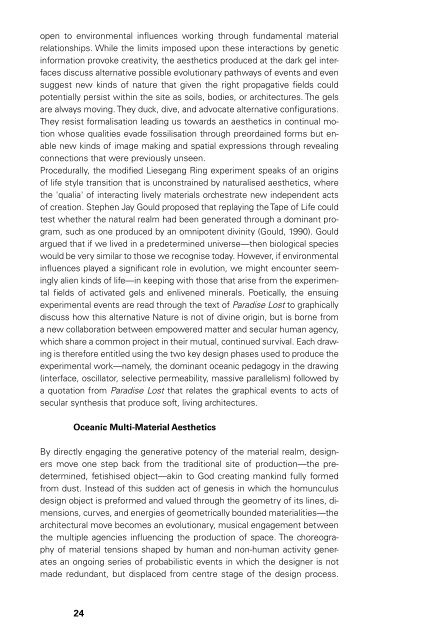Mixed Matters
ISBN 978-3-86859-421-8
ISBN 978-3-86859-421-8
You also want an ePaper? Increase the reach of your titles
YUMPU automatically turns print PDFs into web optimized ePapers that Google loves.
open to environmental influences working through fundamental material<br />
relationships. While the limits imposed upon these interactions by genetic<br />
information provoke creativity, the aesthetics produced at the dark gel interfaces<br />
discuss alternative possible evolutionary pathways of events and even<br />
suggest new kinds of nature that given the right propagative fields could<br />
potentially persist within the site as soils, bodies, or architectures. The gels<br />
are always moving. They duck, dive, and advocate alternative configurations.<br />
They resist formalisation leading us towards an aesthetics in continual motion<br />
whose qualities evade fossilisation through preordained forms but enable<br />
new kinds of image making and spatial expressions through revealing<br />
connections that were previously unseen.<br />
Procedurally, the modified Liesegang Ring experiment speaks of an origins<br />
of life style transition that is unconstrained by naturalised aesthetics, where<br />
the 'qualia' of interacting lively materials orchestrate new independent acts<br />
of creation. Stephen Jay Gould proposed that replaying the Tape of Life could<br />
test whether the natural realm had been generated through a dominant program,<br />
such as one produced by an omnipotent divinity (Gould, 1990). Gould<br />
argued that if we lived in a predetermined universe—then biological species<br />
would be very similar to those we recognise today. However, if environmental<br />
influences played a significant role in evolution, we might encounter seemingly<br />
alien kinds of life—in keeping with those that arise from the experimental<br />
fields of activated gels and enlivened minerals. Poetically, the ensuing<br />
experimental events are read through the text of Paradise Lost to graphically<br />
discuss how this alternative Nature is not of divine origin, but is borne from<br />
a new collaboration between empowered matter and secular human agency,<br />
which share a common project in their mutual, continued survival. Each drawing<br />
is therefore entitled using the two key design phases used to produce the<br />
experimental work—namely, the dominant oceanic pedagogy in the drawing<br />
(interface, oscillator, selective permeability, massive parallelism) followed by<br />
a quotation from Paradise Lost that relates the graphical events to acts of<br />
secular synthesis that produce soft, living architectures.<br />
Oceanic Multi-Material Aesthetics<br />
By directly engaging the generative potency of the material realm, designers<br />
move one step back from the traditional site of production—the predetermined,<br />
fetishised object—akin to God creating mankind fully formed<br />
from dust. Instead of this sudden act of genesis in which the homunculus<br />
design object is preformed and valued through the geometry of its lines, dimensions,<br />
curves, and energies of geometrically bounded materialities—the<br />
architectural move becomes an evolutionary, musical engagement between<br />
the multiple agencies influencing the production of space. The choreography<br />
of material tensions shaped by human and non-human activity generates<br />
an ongoing series of probabilistic events in which the designer is not<br />
made redundant, but displaced from centre stage of the design process.<br />
24


















